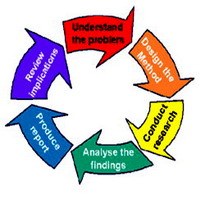Lesson 4: Research Methods
Attention

Research, particularly in the social science, is a circular process, not a linear one!
Learning Outcomes
Upon completion of this lesson's material, students will be able to:
- Identify the basic components of a research study.
- Demonstrate an understanding of the difference between statistical and clinical significance.
- Discuss the difference between correlational and experimental research designs.
- Discuss basic ethical considerations in conducting research.
Teaching
Chapter 4-Research Methods
Suppose that you suffer from Bipolar II disorder and have recently been effectively treated with an antidepressant medication to the point where your depressive symptomatology has improved dramatically. Most of the time, your psychiatrist, a physician specializing in the diagnosis and treatment of psychological disorders primarily via the use of medication, will discontinue the use of the antidepressant medication within the next three months. At that point, you will be placed on a drug like Lithium Carbonate to prevent future hypomanic episodes (“high” moods that are not severe enough to be full-blown manic episodes). How do you know that this is the best choice of treatment? Perhaps if you had stayed on your antidepressant medication longer, you would have prevented another depressive episode longer? Or, maybe if you had been asked to stop the medication sooner, you would have prevented another depressive episode even longer? Who decides how the course of treatment should progress?
Questions such as these are best answered through the use of the scientific method. When used correctly, this is a series of procedures designed to answer questions posed in research projects by minimizing bias and error. In clinical psychology and psychiatry, treatment outcome studies are used to verify whether a given type of medication(s) or psychotherapeutic intervention(s) are effective either individually or in combination. In addition to the chapter, let’s take a look at a recently published treatment outcome study investigating just these questions.
Assessment
Lesson 4 Assignment
Open the article from the Journal of Psychiatry. Do your best to answer the following questions:
- What is/are the hypothesis(es)?
- What is/are the independent variable(s)?
- What is/are the dependent variable(s)?
- How was this a double-blind study?
- How was randomization used?
- What was the placebo group?
- What did the study conclude about the continuation of fluoxetine (Prozac)?
- Were there statistical differences between the experimental groups and control group?
- Were the results clinically significant?
- How is an experimental research design different than a correlational study? (use the text to answer this question.)
Lesson 4 Discussion
Go to http://www.apa.org/ethics/code/index.aspx
Consider the following research project. You are a graduate student in psychology who is participating in an experiment to determine the effects of head trauma on long-term memory. The participants are twenty-five rhesus monkeys who are all less than 6 months old and in good health. In addition to college credit and a secondary authorship you will be given $5,000.00 to cover any travel expenses to and from the campus (which is about 25 miles from your home) and another $1,000.00 for your trouble. Before the head trauma is introduced, monkeys would be taught to correctly traverse a maze by using food rewards for each correct turn. Upon completion of the maze, they would be given a full meal. Each monkey must correctly negotiate the maze a minimum of three times in the same day before they are considered to have learned the directions. To simulate head trauma, you are asked to completely anesthetize half of the monkeys (selected at random from their cages) and hit them with a large hammer just above their right eyes. The blow should be sufficient enough to cause bleeding and a large bump. The other half of the monkeys will not receive any head trauma. After 48 hours, each monkey in both groups is placed in the maze again. The hypothesis is that the monkeys who received the head trauma will take longer and make more mistakes while negotiating the maze than those without the injury. The results show that the head trauma group indeed showed more problems with long-term memory than did the control group. The study was published in the Journal of Neuroscience, but, your professor did not list you as a secondary author.
What are ethical issues raised by this study? Please give examples from the study to back up your statements.